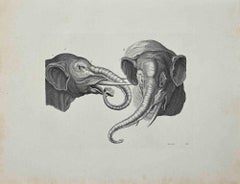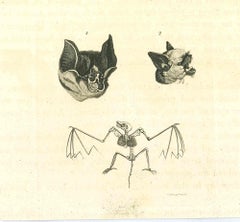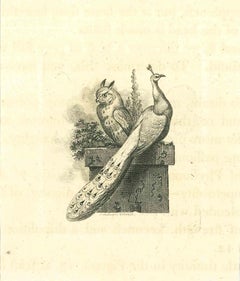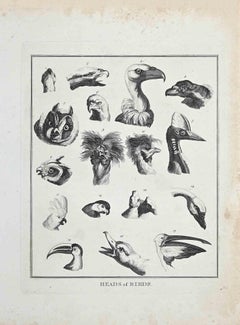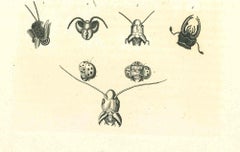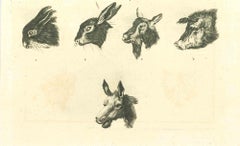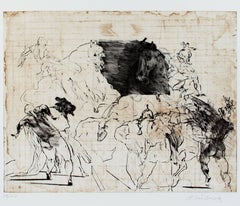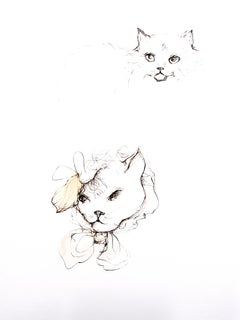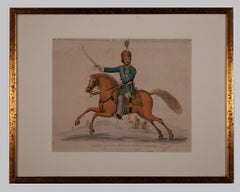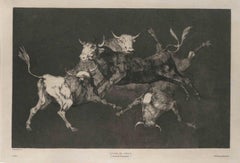1810s Animal Prints
to
12
Overall Width
to
Overall Height
to
8
4
11
1
709
1,435
2,632
1,852
31
29
67
169
102
136
245
605
363
332
678
8
4
6
4
4
3
3
3
3
2
1
1
1
1
1
1
1
1
1
1
1
1
12
Period: 1810s
Elephants - Original Etching by Thomas Holloway - 1810
Located in Roma, IT
Elephants is an etching realized by Thomas Holloway, from J.C. Lavater's "Essays on Physiognomy, Designed to promote the Knowledge and the Love of Mankind", London, Bensley, 1810.
...
Category
Old Masters 1810s Animal Prints
Materials
Etching
The Physiognomy - The Bats - Original Etching by Thomas Holloway - 1810
Located in Roma, IT
The Physiognomy - The Bats is an original etching artwork realized by Thomas Holloway for Johann Caspar Lavater's "Essays on Physiognomy, Designed to Promote the Knowledge and the Lo...
Category
Modern 1810s Animal Prints
Materials
Etching
The Physiognomy - The Owl and the Peacock - Etching by Thomas Holloway - 1810
Located in Roma, IT
The Physiognomy - The owl and peacock is an original etching artwork realized by Thomas Holloway for Johann Caspar Lavater's "Essays on Physiognomy, Designed to Promote the Knowledge...
Category
Modern 1810s Animal Prints
Materials
Etching
Heads of Birds - Original Etching by Thomas Holloway - 1810
Located in Roma, IT
Heads of birds is an original artwork realized by Thomas Holloway (1748 - 1827).
Original Etching from J.C. Lavater's "Essays on Physiognomy, Designed to promote the Knowledge and t...
Category
Old Masters 1810s Animal Prints
Materials
Etching
The Physiognomy - The Insects - Original Etching by Thomas Holloway - 1810
Located in Roma, IT
The Physiognomy - The Insects is an original etching artwork realized by Thomas Holloway for Johann Caspar Lavater's "Essays on Physiognomy, Designed to Promote the Knowledge and the...
Category
Modern 1810s Animal Prints
Materials
Etching
Animals Muzzles - Original Etching by Thomas Holloway - 1810
Located in Roma, IT
The Physiognomy - Animals Muzzles is an original etching artwork realized by Thomas Holloway for Johann Caspar Lavater's "Essays on Physiognomy, Designed to Promote the Knowledge and...
Category
Old Masters 1810s Animal Prints
Materials
Etching
The Physiognomy - The Snakes - Original Etching by Thomas Holloway - 1810
Located in Roma, IT
The Physiognomy - The Snakes is an original etching artwork realized by Thomas Holloway for Johann Caspar Lavater's "Essays on Physiognomy, Designed to Promote the Knowledge and the ...
Category
Modern 1810s Animal Prints
Materials
Etching
The Physiognomy - The Face - Original Etching by Thomas Holloway - 1810
Located in Roma, IT
The Physiognomy - The faces is an original etching artwork realized by Thomas Holloway for Johann Caspar Lavater's "Essays on Physiognomy, Designed to Promote the Knowledge and the L...
Category
Modern 1810s Animal Prints
Materials
Etching
Animals Muzzles - Original Etching by Thomas Holloway - 1810
Located in Roma, IT
Animals Muzzles is an original etching artwork realized by Thomas Holloway for Johann Caspar Lavater's "Essays on Physiognomy, Designed to Promote the Knowledge and the Love of Manki...
Category
Modern 1810s Animal Prints
Materials
Etching
The Child and the Monkey - Original Etching by Thomas Holloway - 1810
Located in Roma, IT
The Child and the Monkey is an original etching artwork realized by Thomas Holloway for Johann Caspar Lavater's "Essays on Physiognomy, Designed to Promote the Knowledge and the Love...
Category
Modern 1810s Animal Prints
Materials
Etching
The Birds - Original Etching by Thomas Holloway - 1810
Located in Roma, IT
The Physiognomy - The birds of animals is an original etching artwork realized by Thomas Holloway for Johann Caspar Lavater's "Essays on Physiognomy, Designed to Promote the Knowledg...
Category
Modern 1810s Animal Prints
Materials
Etching
Heads of Animals - Original Etching by John Barlow - 1810
By John Barlow
Located in Roma, IT
Heads of animals is an original artwork realized by John Barlow (1759 - 1810).
Original Etching from J.C. Lavater's "Essays on Physiognomy, Designed to promote...
Category
Old Masters 1810s Animal Prints
Materials
Etching
Related Items
20th century drypoint etching figurative animal print horses sketch signed
Located in Milwaukee, WI
"Combat Equestre" is an original lithograph by Claude Weisbuch. The artist signed the piece lower right and wrote the edition number (24/100) in the lower left. This piece depicts mu...
Category
Modern 1810s Animal Prints
Materials
Drypoint, Etching
$4,050
H 27.25 in W 31.25 in
Leonor Fini - Cats - Original Etching
By Leonor Fini
Located in Collonge Bellerive, Geneve, CH
Leonor Fini - Cats - Original Engraving
Mme.Helvetius' Cats
Original etching created in 1985, Printed Signature (LF).
Conditions: excellent
Edition: 100
Support: Arches paper.
Dimensions: Paper dimensions: 44 x 28 cm
Editions: Moret, Paris.
Leonor Fini is considered one of the most important women artists of the mid-twentieth century, along with Leonora Carrington, Frida Kahlo, Meret Oppenheim, Remedios Varo, and Dorothea Tanning – most of whom Fini knew well. Her career, which spanned some six decades, included painting, graphic design, book illustration, product design (the renowned torso-shaped perfume bottle for Schiaparelli’s Shocking), and set and costume design for theatre, ballet, opera, and film. In this compellingly readable, exhaustively researched account, author Peter Webb brings Fini’s provocative art and unconventional personal life, as well as the vibrant avant-garde world in which she revolved, vividly in life.
Born in Buenos Aires in 1907 (August 30 – January 18, 1996, Paris) to Italian and Argentine parents, Leonor grew up in Trieste, Italy, raised by her strong-willed, independent mother, Malvina. She was a virtually self-taught artist, learing anatomy directly from studying cadavers in the local morgue and absorbing composition and technique from the Old Masters through books and visits to museums.
Fini’s fledging attempts at painting in Trieste let her to Milan, where she participated in her first group exhibition in 1929, and then to Paris in 1931.
Her vivacious personality and flamboyant attire instantly garnered her a spotlight in the Parisian art world and she soon developed close relationships with the leading surrealist writers and painters, including Paul Eluard, Salvador Dali, Man Ray, and Max Ernst, who became her lover for a time. The only surrealist she could not abide because of his misogyny was André Breton. Although she repeatedly exhibited with them, she never considered herself a surrealist. The American dealer Julien Levy,
very much impressed by Fini’s painting and smitten by her eccentric charms, invited her to New York in 1936, where she took part in a joint gallery exhibition with Max Ernst and met many American surrealists, including Joseph Cornell and Pavel Tchelitchew. Her work was included in MoMA’s pivotal Fantastic Art, Dada and Surrealism exhibition, along with De Chirico, Dali, Ernst, and Yves Tanguy.
In 1939 in Paris she curated an exhibition of surrealist furniture for her childhood friend Leo Castelli for the opening of his first gallery.
Introductions to her exhibition catalogues were written by De Chirico, Ernst, and Jean Cocteau.
A predominant theme of Fini’s art is the complex relationship between the sexes, primarily the interplay between the dominant female and the passive, androgynous male. In many of her most powerful works, the female takes the form of a sphinx, often with the face of the artist. Fini was also an accomplished portraitist; among her subjects were Stanislao Lepri...
Category
Modern 1810s Animal Prints
Materials
Etching
17th century etching animal print sketch ram sheep black and white signed
Located in Milwaukee, WI
"Two Rams Looking Down & To Their Left" is an original etching by Karel DuJardin. DuJardin completed many delicate etchings of rams.
3 3/4" x 7 3/4" art
16 3/8" x 19 1/2" frame
Du Jardin was a master of various genres of painting, including refined and tranquil Italianising landscapes, monumental historical paintings and superb portraits of the aristocracy.
Unlike the majority of his contemporaries, Karel du Jardin (b. Amsterdam 1626, d. Venice 1678) was a talented painter in not one, but many different genres. He is especially famous for his small-scale landscapes, such as the charming Italian landscape with a woman milking a goa" (1652) from the Rijksmuseum's collection. Du Jardin depicted both sun-filled Italianate scenes and Dutch farmyards with pigs and sheep. He also painted a range of elegant portraits of aristocrats and merchants. His self-portrait (1662) on copper is one of the most fascinating 17th-century portraits of a Dutch artist. Du Jardin's spectacular large-scale historical pieces, represented is the show by the impressive Conversion of Saint Pau" (1662) from the collection of the National Gallery of London, are among his most remarkable achievements; he often chose themes that were only rarely depicted by other Dutch painters of the period.
During his own lifetime Du Jardin was praised by poets and writers, particularly for his attention to detail and elegant painting technique. As Cornelis de Bie, the artist’s biographer, wrote in 1661: "the surety of the brush at his finger and such sharpe clarity […] that the eye thereon doth linger." Du Jardin's valuable paintings were mainly purchased by rich individuals with an eye for elegance, but were also commissioned by prominent institutions such as the Amsterdam 'Spinhuis' (a women's prison), for whom he painted a vast group portrait of the prison-governors.
Karel du Jardin was an artist who liked to travel. He lived for a time in Lyon and in Paris, and sailed with Joan Reynst, Heer van Drakestein, by ship via England, Portugal and Spain to Tangier and Algiers, where they met Michiel de Ruyter...
Category
Old Masters 1810s Animal Prints
Materials
Etching
$1,600
H 16.375 in W 19.125 in
A Fierce Bull
By James McBey
Located in Storrs, CT
A Fierce Bull. 1911. Drypoint. Hardie 108. 5 3/8 x 8 (sheet 8 5/16 x 11 7/8). Edition 8. An exceptional impression with rich drypoint burr printed on antique laid paper. A proof of t...
Category
Modern 1810s Animal Prints
Materials
Drypoint, Etching
Tigre couché à l'entrée de son antre (Tiger Lying at the Entrance to its Lair)
Located in Middletown, NY
Etching, drypoint, and roulette on watermarked Hallines cream laid paper, 3 3/4 x 5 7/8 inches (95 x 148 mm), full margins. A very good impression of this charming image, with all of...
Category
Realist 1810s Animal Prints
Materials
Laid Paper, Drypoint, Etching
A Standing Leap at a Gate
Located in Stoke, Hampshire
James Seymour (1702-1752)
A Standing Leap at a Gate
Mezzotint with hand colouring
Image size 10 x 14 in
Framed size 16 1/2 x 20 in
James Seymour was an English artist renowned for h...
Category
Old Masters 1810s Animal Prints
Materials
Mezzotint
Le Millouinan /// Ornithology Martinet Bird Animal Art Duck Natural History
Located in Saint Augustine, FL
Artist: François-Nicolas Martinet (French, 1731-1800)
Title: "Le Millouinan" (Plate 1002)
Portfolio: Histoire Naturelle Des Oiseaux
*Signed by Martinet in the plate (printed signatur...
Category
Old Masters 1810s Animal Prints
Materials
Watercolor, Laid Paper, Engraving, Intaglio
Putorius & Pseudo Phalangium (The Pole-Cat) (Skunk) /// Mark Catesby Animal Art
By Mark Catesby
Located in Saint Augustine, FL
Artist: Mark Catesby (English, 1638-1749)
Title: "Putorius & Pseudo Phalangium (The Pole-Cat) (Skunk)" (Plate/Tab 62)
Portfolio: Natural History of Carolina, Florida & the Bahama Isl...
Category
Old Masters 1810s Animal Prints
Materials
Watercolor, Handmade Paper, Etching, Intaglio
From the suite "Les Fables De La Fontaine" original etching
By Marc Chagall
Located in San Francisco, CA
Artist: Marc Chagall (Russian, 1887-1985)
Title: From the suite "Les Fables De La Fontaine"
Year: 1927
Medium: Original etching
Edition: fom...
Category
Modern 1810s Animal Prints
Materials
Etching
$2,100
H 25.5 in W 22.25 in D 1.75 in
Night Time, Dieppe.
Located in Storrs, CT
Night Time, Dieppe. 1926-27. Drypoint. Appleby 123. 7 7/8 x 11/ Edition 100. A fine impression printed on cream laid paper with full margins. Signed in penc...
Category
Modern 1810s Animal Prints
Materials
Drypoint, Etching
Mexican signed limited edition orginal print mezzotint 17.4x13.8 in.
Located in Miami, FL
Fernando Aceves Humana (Mexico, 1969)
'Lo que nos trajeron', 2007
mezzotint on paper
17.4 x 13.8 in. (44 x 35 cm.)
Edition of 20
ID: ACE-101
Unframed
Category
Contemporary 1810s Animal Prints
Materials
Paper, Etching, Screen, Mezzotint
Salvador Dali - Le Cerf from Le Bestiaire de la Fontaine - Signed Engraving
Located in Collonge Bellerive, Geneve, CH
SALVADOR DALI
Le Cerf se voyant dans l'eau from Le Bestiaire de la Fontaine
1974
Hand signed by Dali
Edition: /250
The dimensions of the image are 22.8 x 15.7 inches on 31 x 23.2 in...
Category
Surrealist 1810s Animal Prints
Materials
Drypoint, Aquatint
$2,994
H 29.93 in W 22.84 in D 0.04 in
Previously Available Items
Count Platoff, Hetman of Cossacks - Original Lithograph - 1819
Located in Roma, IT
Count Platoff, Hetman of Cossacks is an original artwork realized in 1819 by Anonymous artist.
Mixed colored hand-watercolored lithograph on paper.
Titled print on plate on the lo...
Category
1810s Animal Prints
Materials
Lithograph
Lluvia De Toros - Original Etching by F. Goya - 1815/19
Located in Roma, IT
Francisco Goya, Lluvia de Toros/ Disparate’ dei torelli / Pioggia di tori/
Etching, Acquatint and Drypoint, on fine laid paper, color ivory. Black ink printing. In good condition w...
Category
1810s Animal Prints
Materials
Etching
H 11.11 in W 15.91 in D 0.04 in
Whale Fishery, a set of four colour aquatints after John Heavenside Clark, 1813
Located in Melbourne, Victoria
A complete set of four fine colour aquatints depicting whaling in the early 19th century. Fine original colour. The titles of each plate : 'Whale Fishery...
Category
Victorian 1810s Animal Prints
Materials
Aquatint
Lluvia De Toros - Original Etching by F. Goya - 1815/19
Located in Roma, IT
Francisco Goya, Lluvia de Toros/ Disparate’ dei torelli / Pioggia di tori/
Etching, Acquatint and Drypoint, on fine laid paper, color ivory. Black ink printing. In good condition w...
Category
1810s Animal Prints
Materials
Etching
H 11.11 in W 15.91 in D 0.04 in
Hindoo Method of Taming Elephants
Located in Saint Augustine, FL
An original hand -colored aquatint on J. Whatman watermarked paper of Exotic Hunting & Sporting Scenes by English artist Samuel Howitt (1756-1822) titled "Hindoo Method of Taming Elephants", 1813. Published and sold 1813, Edward Orne, Bond Street, London. Framed size: 12.25" x 14". Image size: 5.25" x 7.25". Some light toning to paper. In overall good condition.
Howitt was a member of an old Nottinghamshire Quaker family. In early life he lived at Chigwell, near Epping Forest, Essex, was financially independent and devoted himself to field sports. However he ran into financial difficulties and was obliged to turn to art as a profession - which up until then he had engaged in as a talented amateur.
Coming to London, he was for a time a drawing master at Samuel Goodenough's school in Ealing. In 1783, he exhibited 3 coloured drawings of hunting subjects with the Incorporated Society of Artists. From time to time he continued to exhibit there and at the Royal Academy, beginning in 1784 with a hunting piece, followed in 1785 by two landscapes - "A view of the ruins of an abbey" and "Fairlop Oak". In 1793 he showed "Jaques and the Deer" and "A Fox Hunt"; in 1794, "Smugglers alarmed"; in 1800, two pictures titled "Deer"; in 1814 "Dead game"; and in 1815, "Bella, horrida Bella". He probably exhibited so little because he was in such demand as a commercial illustrator.
Howitt worked both in oils and water-colours, for the most part confining himself to sporting subjects and illustrations of natural history, which were carefully executed, spirited and truthful. These, as Howitt represented in his New Work of Animals, were “drawn from the life" and published so as to "assist the pencil of the designer who has not had an opportunity to pay the same attention to this branch of the art”. However, notes in one sketchbook containing watercolours of apes and monkeys indicate that, while some there certainly were viewed in private menageries, others were studies of stuffed specimens from William Bullock’s museum and the British Museum.
Howitt was closely associated in his art with Thomas Rowlandson, whose sister he married, and his works did, at one time, often pass for those of his brother-in-law; but, unlike Rowlandson, he was a practical sportsman, and his scenes were more accurately composed. He was a clever and industrious etcher, and published a great number of plates similar in character to his drawings, and delicately executed with a fine needle. He also produced a number of caricatures in the manner of Rowlandson.
Howitt was particularly noted for the illustrations in (Captain) Thomas Williamson's Oriental Field Sports...
Category
Victorian 1810s Animal Prints
Materials
Aquatint, Engraving
Turtle Fishing in the Water
Located in Saint Augustine, FL
An original hand -colored aquatint on J. Whatman watermarked paper of Exotic Hunting & Sporting Scenes by English artist Samuel Howitt (1756-1822) titled "Turtle Fishing in the Water", 1813. Published and sold 1813, Edward Orne, Bond Street, London. Framed size: 12.25" x 14". Image size: 5.25" x 7.25". Good condition.
Howitt was a member of an old Nottinghamshire Quaker family. In early life he lived at Chigwell, near Epping Forest, Essex, was financially independent and devoted himself to field sports. However he ran into financial difficulties and was obliged to turn to art as a profession - which up until then he had engaged in as a talented amateur.
Coming to London, he was for a time a drawing master at Samuel Goodenough's school in Ealing. In 1783, he exhibited 3 coloured drawings of hunting subjects with the Incorporated Society of Artists. From time to time he continued to exhibit there and at the Royal Academy, beginning in 1784 with a hunting piece, followed in 1785 by two landscapes - "A view of the ruins of an abbey" and "Fairlop Oak". In 1793 he showed "Jaques and the Deer" and "A Fox Hunt"; in 1794, "Smugglers alarmed"; in 1800, two pictures titled "Deer"; in 1814 "Dead game"; and in 1815, "Bella, horrida Bella". He probably exhibited so little because he was in such demand as a commercial illustrator.
Howitt worked both in oils and water-colours, for the most part confining himself to sporting subjects and illustrations of natural history, which were carefully executed, spirited and truthful. These, as Howitt represented in his New Work of Animals, were “drawn from the life" and published so as to "assist the pencil of the designer who has not had an opportunity to pay the same attention to this branch of the art”. However, notes in one sketchbook containing watercolours of apes and monkeys indicate that, while some there certainly were viewed in private menageries, others were studies of stuffed specimens from William Bullock’s museum and the British Museum.
Howitt was closely associated in his art with Thomas Rowlandson, whose sister he married, and his works did, at one time, often pass for those of his brother-in-law; but, unlike Rowlandson, he was a practical sportsman, and his scenes were more accurately composed. He was a clever and industrious etcher, and published a great number of plates similar in character to his drawings, and delicately executed with a fine needle. He also produced a number of caricatures in the manner of Rowlandson.
Howitt was particularly noted for the illustrations in (Captain) Thomas Williamson's Oriental Field Sports...
Category
Victorian 1810s Animal Prints
Materials
Aquatint, Engraving
Still Thinking About These?
All Recently ViewedMore Ways To Browse
Penguin Lithograph
Peter Klucik
Pheasant Engraving
Picasso Dove Of Peace
Picasso Le Taureau
Picasso Rooster
Ronald Smith
Rooster Print Picasso
Salvador Dali Argus
Salvador Dali Unicorn
Sam Savitt
Shore Bird Print
Space Elephant Dali
Szabolcs Bozo
The Toad Picasso
Vintage Forest Service Posters
Vintage Posters Coppertone
Warhol Siberian Tiger
